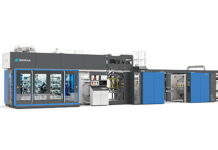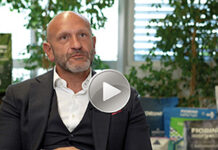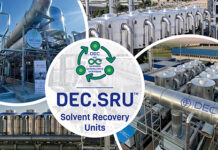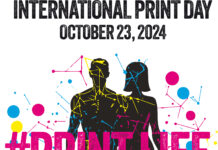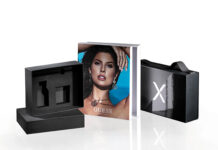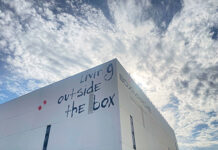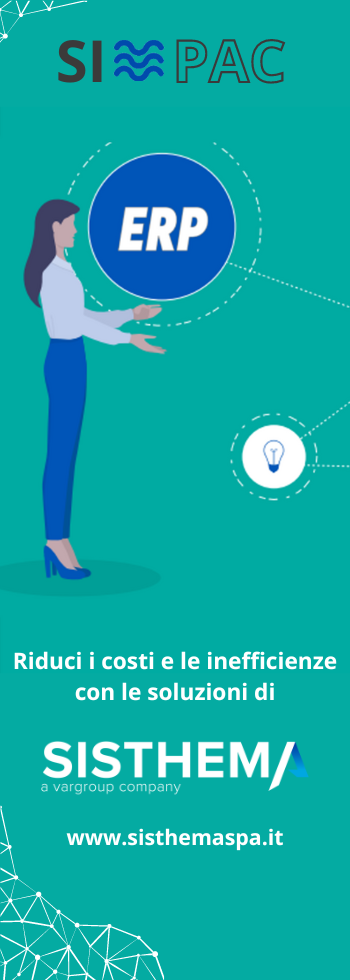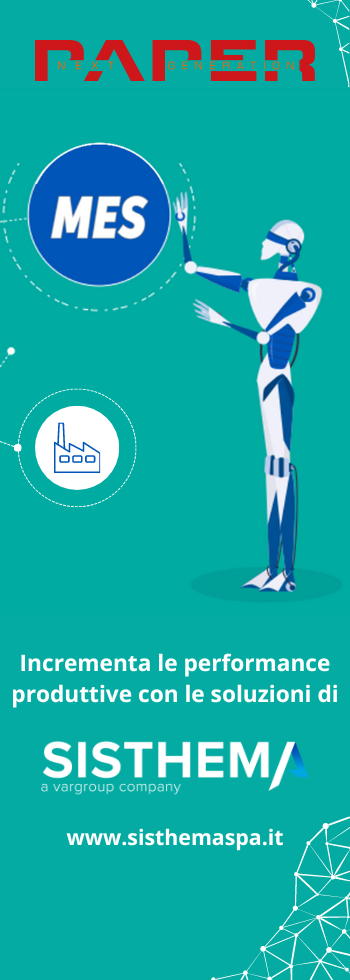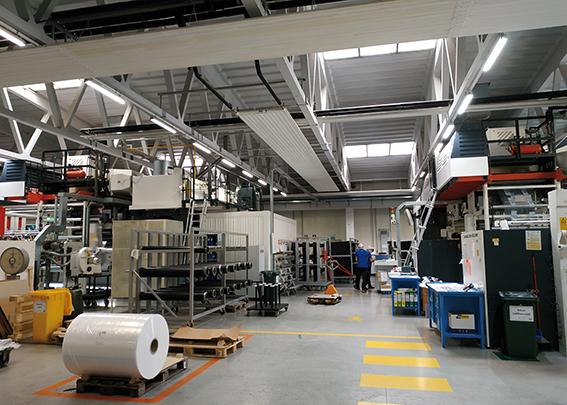 On the occasion of the Global Flexo Innovation Awards organized by Miraclon this year, Fotolito Veneta, a flexo prepress service based in San Martino Buon Albergo (VR) and Imball Center, a flexo printer of flexible packaging that prints only with water-based inks and based near Lucca, won in the following categories of excellence: Transformation from other printing processes and Creative use of graphic design. The packages for Rafael Caffè Expresso Arabica were awarded
On the occasion of the Global Flexo Innovation Awards organized by Miraclon this year, Fotolito Veneta, a flexo prepress service based in San Martino Buon Albergo (VR) and Imball Center, a flexo printer of flexible packaging that prints only with water-based inks and based near Lucca, won in the following categories of excellence: Transformation from other printing processes and Creative use of graphic design. The packages for Rafael Caffè Expresso Arabica were awarded
Giulio Storace founded Fotolito Veneta in 1969. At start the company was active in the publishing sector and reproduction of art books in Italy and abroad, but at the beginning of 2000s, when publishing world began to show signs of slowing down, “we realized that the focus of our activity had to change and the flexo sector had good development possibilities, therefore we have become a prepress service dedicated mainly to the flexo printed packaging sector”, says Andrea Storace, sales manager. Today the customers of Fotolito Veneta belong to the food and non-food sector. The company deals with the graphic preparation of the file that comes from agencies, graphic studios or directly from the customer, and adapts it to the needs of flexo printing, carefully evaluating the subject, establishing the separations and the number of colors needed for a quality print , analyzing all the variables with great care. Fotolito Veneta is a virtuous example of the evolution of a company: they have succeeded in transferring to the flexo sector the experience in color management deriving from years of work as a ‘classic’ prepress service operating in offset and gravure prepress.
Fotolito Veneta, where 20 people work, has always been loyal to Kodak: the installation of the first Kodak Flexcel NX dates back to 2010, followed in 2014 by the installation of a Kodak Flexcel Wide NX-C with Digicap NX screening; Kodak Prinergy for workflow management.
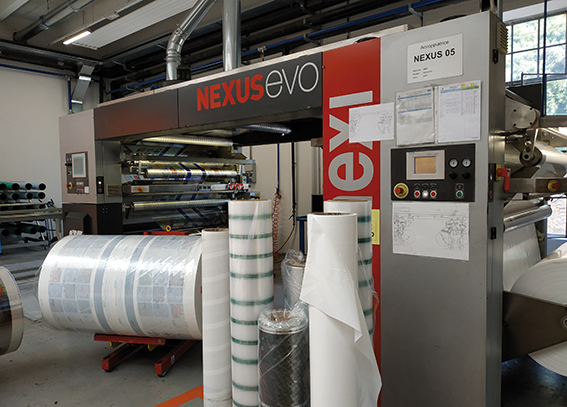 Imball Center was founded in 1982, at the beginning the activity included in addition to flexo printing also welding and extrusion (abandoned in 2000). Today the core business of the company, 60 employees, is the production of flexible packaging for the food industry, thermal envelopes for the transport of frozen food (company’s invention, patented in 1982, in fact they are the only ones to produce them in Italy, always without solvent) and packages for tissue, considered the proximity to many Tuscan paper mills producing this material. There are two Imball Center factories: one in Piaggione, where two 8-color central drum flexo printing machines and laminators are in operation, the other in Pescaglia, where are welded the materials produced in the first. It is worth remembering the history of Piaggione site, a former cotton manufacturer, owned by Imball Center since 2006, and in full operation since 4 years. “This has been an important step in the development strategy of the company, which instead of constructing and cementing further, has chosen to restructure giving life to an absolutely environmentally friendly production site, because it has an autonomous hydroelectric plant. Furthermore, thanks to the important decision taken at the end of 2015 to switch to water-based inks with two W&H central flexo machines, twin and technologically advanced, the introduction of polluting materials has been reduced to a minimum”, says Nicola Giuliani, Marketing & Development manager of Imball Center. The two machines also print with water-based inks on plastic film and work up to 144 lines/ cm, (the production standard is 60 lines/cm), with quality results comparable to gravure.
Imball Center was founded in 1982, at the beginning the activity included in addition to flexo printing also welding and extrusion (abandoned in 2000). Today the core business of the company, 60 employees, is the production of flexible packaging for the food industry, thermal envelopes for the transport of frozen food (company’s invention, patented in 1982, in fact they are the only ones to produce them in Italy, always without solvent) and packages for tissue, considered the proximity to many Tuscan paper mills producing this material. There are two Imball Center factories: one in Piaggione, where two 8-color central drum flexo printing machines and laminators are in operation, the other in Pescaglia, where are welded the materials produced in the first. It is worth remembering the history of Piaggione site, a former cotton manufacturer, owned by Imball Center since 2006, and in full operation since 4 years. “This has been an important step in the development strategy of the company, which instead of constructing and cementing further, has chosen to restructure giving life to an absolutely environmentally friendly production site, because it has an autonomous hydroelectric plant. Furthermore, thanks to the important decision taken at the end of 2015 to switch to water-based inks with two W&H central flexo machines, twin and technologically advanced, the introduction of polluting materials has been reduced to a minimum”, says Nicola Giuliani, Marketing & Development manager of Imball Center. The two machines also print with water-based inks on plastic film and work up to 144 lines/ cm, (the production standard is 60 lines/cm), with quality results comparable to gravure.
Since the company has eliminated solvent inks there is no longer need of distillers and plants to reduce emissions, and electricity is also saved: so if we also consider the impact on the lower quantity of material produced by its suppliers, the global quantity of CO2 not emitted into the atmosphere reaches about one million kilos in a year. Today the company has the AUA authorization, which certifies a low environmental impact; the migration of packaging inks is often below the figure that can be detected by the laboratory performing the analyzes. Last July came the ABRC certification, Global Standard for packaging and packaging materials issue 5, that is the guarantee of a high hygiene for the packaging of food or products that are in contact with the body.
Continuous technical innovation
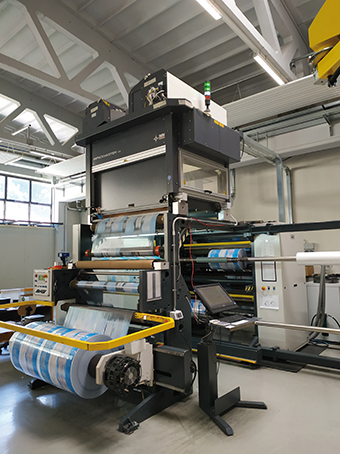 “Our goal has always been to guarantee the efficiency and maximum performance for flexible packaging that we produce, offering advice and trying to continuously improve the service, establishing a relationship of trust between supplier and customer. That of Imball Center is a daily challenge in search of the most appropriate technical innovation for the market, in line with customer expectations and with the technological evolutions of flexible packaging printing, carefully selecting raw materials; our certifications related to food compliance and our level of innovation have allowed us to successfully propose ourselves to the giants of the sector”, says Giuliani. Print quality is also positively perceived by customers, as well as the great flexibility that allows the company to receive and manage orders, optimizing the production process.
“Our goal has always been to guarantee the efficiency and maximum performance for flexible packaging that we produce, offering advice and trying to continuously improve the service, establishing a relationship of trust between supplier and customer. That of Imball Center is a daily challenge in search of the most appropriate technical innovation for the market, in line with customer expectations and with the technological evolutions of flexible packaging printing, carefully selecting raw materials; our certifications related to food compliance and our level of innovation have allowed us to successfully propose ourselves to the giants of the sector”, says Giuliani. Print quality is also positively perceived by customers, as well as the great flexibility that allows the company to receive and manage orders, optimizing the production process.
Francesco Falaschi, production manager, adds that “an R&D team is also active in the company dedicated to the study of inks and supports, to marketing and commercial strategies, to improvement of production and quality, to the further reduction of environmental impact packaging; we have new projects that we also develop with customers, such as extended gamut printing and recyclable plastic printing”.
Collaborating and growing together to reach the maximum: the silver award at the Global
Flexo Innovation Awards
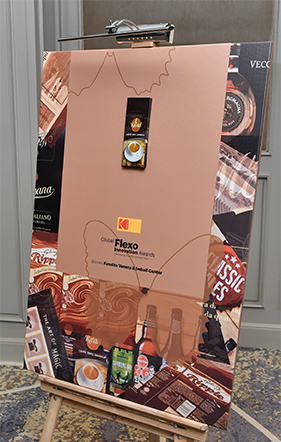 The relationship between Fotolito Veneta and Imball Center was born 15 years ago, and it is precisely the desire to improve and innovate that linked service and printer, who grew up together. “From the technical point of view they have always supported us, following the logic of credibility and quality of plates, I am convinced that if you work well, the work develops, because it is like water that flows easily where it meets less resistance”, he says. Giuliani.
The relationship between Fotolito Veneta and Imball Center was born 15 years ago, and it is precisely the desire to improve and innovate that linked service and printer, who grew up together. “From the technical point of view they have always supported us, following the logic of credibility and quality of plates, I am convinced that if you work well, the work develops, because it is like water that flows easily where it meets less resistance”, he says. Giuliani.
Fotolito Veneta is the election service for Imball Center. “When we switched to solvent-free printing, Fotolito Veneta developed the right color curves, so with their plates the desired results are achieved first and work better. And the quality guaranteed by Kodak today really makes the difference, because customers tend to reduce the number of colors, trying to create more complicated graphics with 5 or 6 colors. And it is precisely in these cases that Kodak technology becomes truly essential, because it allows us to give strength to solids but also to manage screens effectively”, explains Falaschi.
“The relationship with Imball Center has always been very dialectical, in fact we always exchange views when we make a color selection, especially now that they use water-based inks. For us it was a challenge and a learning path: every job is checked according to the established parameters, thus managing to get the maximum, for many jobs we also check the color proofs, to check the minimum and maximum values and analyze dot density at the beginning and at the end of the print run”, states Storace.
The awarded packaging printed with water-based inks
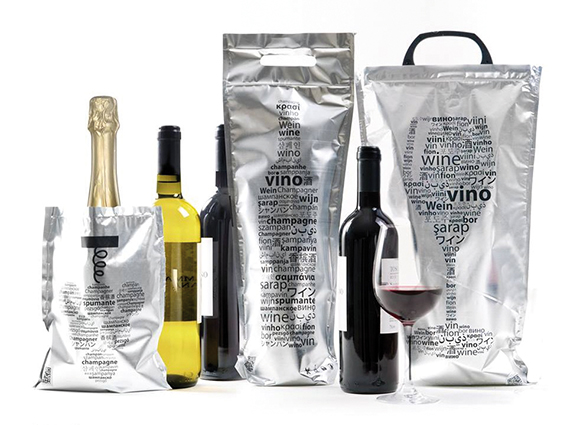 This apparently simple subject presented some technical difficulties to be overcome in order to obtain an excellent printing result. First of all, it is a subject previously printed in gravure. It was therefore necessary to be able to give the same color coverage on the background, maintaining the negative texts open and legible.
This apparently simple subject presented some technical difficulties to be overcome in order to obtain an excellent printing result. First of all, it is a subject previously printed in gravure. It was therefore necessary to be able to give the same color coverage on the background, maintaining the negative texts open and legible.
The orange background of one of the awarded packages was realized with a single color passage, obtaining a very good density, thanks to the perfect ink laying down possible with Kodak Flexcel Nx plates.The printed material is 12 micron pet laminated with 8 micron aluminum + 100 micron PE. Therefore, during the prepress it was necessary to provide for the color modification during the laminating process.
The subject was created without continuous sleeves and from the beginning to the end of the print run, print has been homogeneous and minimum dots have not been crushed. The shift from gravure to flexographic has allowed a reduction in times to put on shelf the product with 40% saving and a time-to-market of 37 days against the previous 59. It should also be underlined that the film was printed with water-based inks, reducing dramatically the environmental impact of printed film production.
This was only possible thanks to the excellent integration among Imball Center, Fotolito Veneta and Kodak Flexcel NX plates, which produced a flexo printed packaging with an incredible high print quality and at the same time sustainable.






